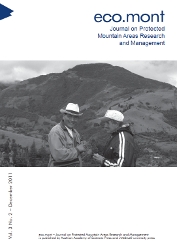Reto Rupf,
Martin Wyttenbach,
Daniel Köchli,
Martina Hediger,
Salome Lauber,
Pascal Ochsner,
Roland Graf
S. 23 - 32
doi:
10.1553/eco.mont-3-2s23
Verlag der Österreichischen Akademie der Wissenschaften
doi:
10.1553/eco.mont-3-2s23
Abstract:
Outdoor activities may have serious consequences for wildlife species that are sensitive to human disturbance. The pressure of outdoor activities on natural landscapes has increased dramatically in recent decades. However, we generally lack information on the spatial and temporal patterns of outdoor activities – a fact that makes it difficult to quantify the impact on wildlife and thus to implement and justify measures to constrain outdoor activities. In the winter seasons 2008 / 2009 and 2009 / 2010, we equipped 303 recreationists in the Val Müstair Biosphere Reserve, eastern Swiss Alps, with GPS loggers to record their spatial and temporal pattern of landscape use. We then analysed how the resulting pattern of spatial use overlapped with the habitat of capercaillie Tetrao urogallus, an endangered woodland grouse species that is highly sensitive to disturbance. For our study we used the official capercaillie core winter habitats observed by the game wardens of the Canton Grisons. The recorded 319 trips of 188 backcountry skiers and snowboarders and 231 trips of 115 snowshoers combined show an inhomogeneous use of subareas in the region. With one exception, the trips are located in the main valley and the adjoining southern and northern slopes and peaks. The trips of snowshoers result in a dispersed use pattern across the main valley, while the trips of the backcountry skiers and snowboarders are concentrated more on official and popular routes. Rarely did recreationists trespass official wildlife sanctuaries or cross capercaillie habitat patches. However, one official, very popular backcountry skiing route crosses one of the largest capercaillie habitats. Here the recorded trips show wide-ranging spatial use with many connectors to the main route. As a consequence, this capercaillie habitat patch is dissected into smaller undisturbed patches. GPS logging in combination with camera trap data provides detailed information on the spatio-temporal land-use pattern of outdoor activities. Based on these data, we identified a conflict of interest in the Val Müstair Biosphere Reserve that has to be resolved by management in a joint participatory process with the main stakeholders. Our methods and results could be transferred to other Alpine regions and be used for any land cover types. In this way we hope to contribute to mitigating conflicts between human outdoor activities and wildlife populations.
GPS-logging backcountry-skiing snowshoeing Tetrao-urogallus wildlife-management visitor-management recreation-ecology human-wildlife-conflict Val-Müstair-Biosphere-Reserve
Published Online:
2011/11/30 10:01:44
Document Date:
2011/12/01 09:43:00
Object Identifier:
0xc1aa5576 0x0029e64c
Rights:https://creativecommons.org/licenses/by-nc-nd/4.0/
The journal “eco.mont” – Journal of protected mountain areas research and management – was published for the first time in June 2009.
The journal was founded as a joint initiative of the Alpine Network of Protected Areas (ALPARC), the International Scientific Committee on Research in the Alps (ISCAR), the Austrian Academy of Sciences (ÖAW) and the University of Innsbruck.
The journal aims to highlight research on and management issues in protected areas in the Alps without excluding other protected mountain areas in Europe or overseas. Its target audiences are scientists from all related disciplines, managers of protected areas and interested individuals including practitioners, visitors, teachers, etc.
The journal presents peer-reviewed articles in English by authors who research protected mountain areas and management issues within these areas. It's published twice a year as a collaboration of the Austrian Academy of Sciences Press – responsible for the e-version – and Innsbruck University Press – responsible for the print version.
Die Zeitschrift „eco.mont“ – Zeitschrift zur Forschung in Gebirgsschutzgebieten – erschien im Juni 2009 zum ersten Mal. Die Zeitschrift wurde auf Initiative des Netzwerks Alpiner Schutzgebiete (ALPARC), der Schweizer Akademie der Naturwissenschaften (ISCAR), der Österreichischen Akademie der Wissenschaften (ÖAW) und der Universität Innsbruck gegründet. Sie hat das Ziel, Themen zu behandeln, die gleichzeitig Forschung und Verwaltung in und über die Schutzgebiete der Alpen betreffen, ohne dabei andere Gebirgsschutzgebiete Europas oder anderswo auszuschließen. Diese neue Zeitschrift richtet sich an ein Publikum von Wissenschaftlern der verschiedensten Fachbereiche, an die Verwalter von Schutzgebieten und an alle sonstigen Interessierten, Praktiker, Besucher, Lehrpersonal etc. einbegriffen. Die Zeitschrift veröffentlicht begutachtete Beiträge auf Englisch von Autoren, die Fragen der Gebirgsschutzgebiete und deren Verwaltung betreffen. Sie erscheint zweimal pro Jahr, auf der Basis der gemeinsamen Anstrengungen des Verlags der Österreichischen Akademie der Wissenschaften, der für die digitale Fassung verantwortlich ist, und der Presse der Universität Innsbruck, verantwortlich für die gedruckte Fassung.



 Home
Home
 Print
Print
 References
References
 Share
Share

